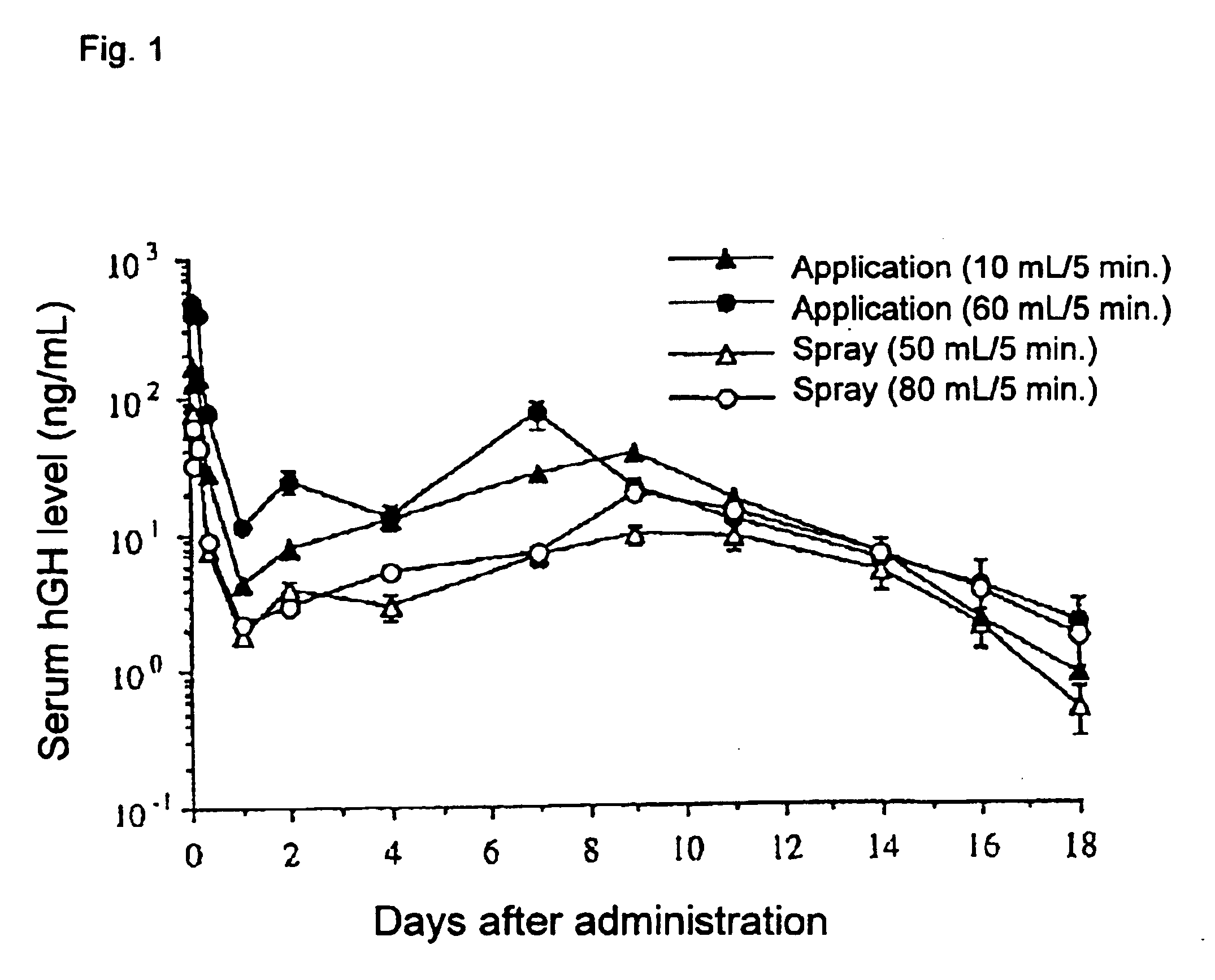Proces for producing protein powder
a technology of protein powder and powder, which is applied in the direction of peptide/protein ingredients, drug compositions, extracellular fluid disorder, etc., can solve the problems of low protein uptake efficiency, frequent administration, repeated injections, etc., and achieve the effect of improving the effect of sustained releas
- Summary
- Abstract
- Description
- Claims
- Application Information
AI Technical Summary
Benefits of technology
Problems solved by technology
Method used
Image
Examples
example 2
Freezing of Aqueous BSA Solution and Subsequent Vacuum Drying
According to the same manner as that described in Example 1, the aqueous BSA solution of Formulation 1 was prepared. The temperature of the solution was adjusted to room temperature and given amount portions thereof of about 0.3 to 0.5 mm fluid diameter were applied to a tray (area: about 1,300 cm.sup.2) on a freeze-dryer shelf cooled at -45 to -40.degree. C. every 5 minutes, and freeze-dried (RL-603BS: Kyowa Vacuum (condensation capacity 60 kg type)) to prepare a BSA powder aseptically. The temperature of the tray during application was -40 to -30.degree. C. By using the resulting BSA powder, the average particle size of the finely divided BSA powder was measured according to the same manner as that described in Example 1.
Table 2 shows the average particle size of the finely divided BSA powder obtained by freezing Formulation 1 according to the above process. The mean cooling rate of Formulation 1 became -98.9.degree. C. / ...
example 3
Freezing of Aqueous hGH Solution and Subsequent Vacuum Drying
Twenty-fold molar equivalent of ammonium acetate was added to an aqueous solution of gene recombinant type hGH (the final concentration of hGH=2 mg / mL) and the mixture was filtered through a 0.22 .mu.m filter to prepare a solution formulation for freeze-drying (Formulation 2). After cooling the solution below 10.degree. C., given amount portions thereof of about 0.3 to 0.5 mm fluid diameter were applied to a tray (area: about 1,300 cm.sup.2) on a freeze-dryer shelf cooled at -45 to -40.degree. C. every 5 minutes, and freeze-dried (Triomaster A04: Kyowa Vacuum (condensation capacity 10 kg type)) to prepare a lyophilized powder (hereinafter abbreviated as hGH powder). The temperature of the tray during application was -40 to -30.degree. C. By using the resulting hGH powder, the average particle size of the finely divided hGH powder was measured according to the same manner as that described in Example 1.
Table 3 shows the ave...
example 4
Freezing of Aqueous hGH Solution and Subsequent Vacuum Drying
Formulation 2 was prepared. The temperature was adjusted to room temperature, and given amount portions thereof of about 0.3 to 0.5 mm fluid diameter were applied to a tray (area: about 1,300 cm ) on a freeze-dryer shelf cooled at -45 to -40.degree. C. every 5 minutes, and freeze-dried (RL-603BS: Kyowa Vacuum (condensation capacity 10 kg type)) to prepare hGR powder aseptically. The temperature of the tray during application was -40 to -30.degree. C. By using the resulting hGH powder, the average particle size of the finely divided hGH powder was measured according to the same manner as that described in Example 1.
Table 4 shows the average particle size of the finely divided hGH powder obtained by freezing Formulation 2 according to the above process. The mean cooling rate of Formulation 2 became -84.6.degree. C. / min. (maximum -87.4.degree. C. / min.) to -67.3.degree. C. / min. (minimum -54.9.degree. C. / min.) by adjusting the ...
PUM
| Property | Measurement | Unit |
|---|---|---|
| Fraction | aaaaa | aaaaa |
| Angle | aaaaa | aaaaa |
| Mass | aaaaa | aaaaa |
Abstract
Description
Claims
Application Information
 Login to View More
Login to View More - R&D
- Intellectual Property
- Life Sciences
- Materials
- Tech Scout
- Unparalleled Data Quality
- Higher Quality Content
- 60% Fewer Hallucinations
Browse by: Latest US Patents, China's latest patents, Technical Efficacy Thesaurus, Application Domain, Technology Topic, Popular Technical Reports.
© 2025 PatSnap. All rights reserved.Legal|Privacy policy|Modern Slavery Act Transparency Statement|Sitemap|About US| Contact US: help@patsnap.com


